85 F. high at St. Cloud Thursday.
52 dew point yesterday.
72 dew point by this evening.
76 dew point expected Saturday evening.
55 dew point predicted for Sunday afternoon, by far the cooler, more comfortable day of the weekend.
*
11 days above 90 so far this summer at MSP. Average for a Twin Cities summer is 13 days.
*
It's All Downhill From Here. With July 15-26 all sharing the highest average high temperatures of the year (84 F. in the Twin Cities), July 20-21 are the median of these days. So climatically, it's getting cooler here in the metro, at least on paper. Then again, you can prove anything with statistics (1971-2000 NWS normals).
"...
The National Weather Service said 141 million people in more than two dozen states were under a heat advisory or warning because of the soaring temperatures." - Reuters story below on the debilitating heat gripping much of the USA.
Remarkable July. According to the National Weather Service: from July 1st through the 19th, 1,149 daily high maximum temperature records were broken along with 3,826 daily high minimum temperature records” - NCDC.
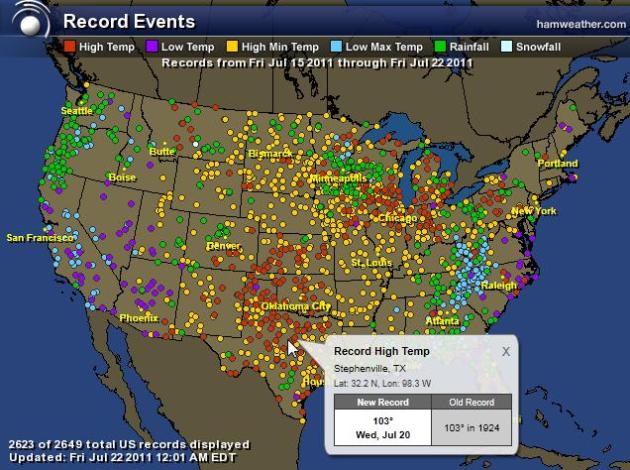 A Week's Worth Of Records
A Week's Worth Of Records. 2,649 records to be exact, mostly record daytime highs and record (warm) nighttime lows. Ham Weather has an interactive look at the records from coast to coast
here.
"...This is just the latest in what has been a remarkable series of extraordinary weather events. America's south is experiencing a record drought. So, too, is the horn of Africa, where a famine may impact millions of people. In late June, an airport in Oman recorded the highest ever low temperature; on the evening of the 27th, the mercury failed to drop below 107 degrees Fahrenheit." - story below in the Economist, over the freakishly severe (and increasingly hot) weather gripping much of the planet in 2011.
Photo Of The Day. This has to be one of the most incredible photos I've ever seen. Details from
NASA: "
This unprecedented view of the space shuttle Atlantis, appearing like a bean sprout against clouds and city lights, on its way home, was photographed by the Expedition 28 crew of the International Space Station. Airglow over Earth can be seen in the background."
Honorable Mention. This photo is a very close runner-up. Thanks to TV meteorologist
Ed Wilson for passing this one along: "
Great storm pic from Grand Junction this morning. Thanks John Reeves! More storms and pics on 13HD tonight."
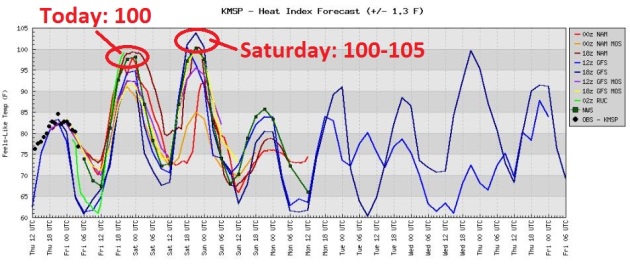 Here We Go Again
Here We Go Again. The combination of upper 80s and a dew point in the mid 70s will make it feel like 97-100 today; dew points may rise close to 80 again Saturday - oppressively/dangerously humid, creating a heat index in the 100-105 range. A surge of cooler, drier air should make for a MUCH more comfortable Sunday, statewide.
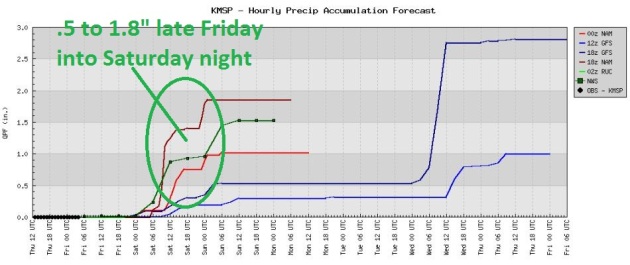 Another Free Watering
Another Free Watering. Models are suggesting significant rainfall amounts with scattered T-storms, some possibly severe later today, again Saturday.
Right now the NWS
is predicting about 1.5" of rain for the metro by Saturday night.
 Tropical Downpours?
Tropical Downpours? The NAM/WRF
model prints out some 4"+ amounts for northeastern Iowa, closer to .5 to .75" for the metro, with a band of 1-2" amounts from near Alexandria eastward to St. Cloud and Hinckley over the next 84 hours.
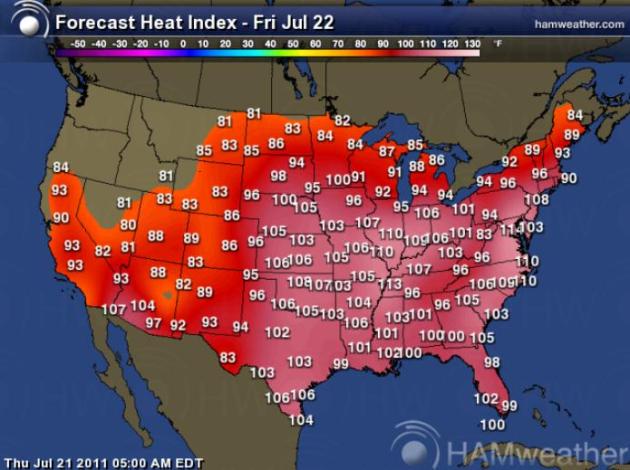 Remarkable In Scope & Duration.
Remarkable In Scope & Duration. Once again today the heat index will top 100 degrees over nearly 2/3rd's of the USA, as high as 108 at New York, 114 in Washington D.C. and 110 at St. Louis. After a one-day break from the humidity a dew point rising into the mid 70s will trigger a heat index close to 100 in the Twin Cities. Meanwhile, dry desert air will mean a downright reasonable heat index of 93 in Las Vegas. Go figure...
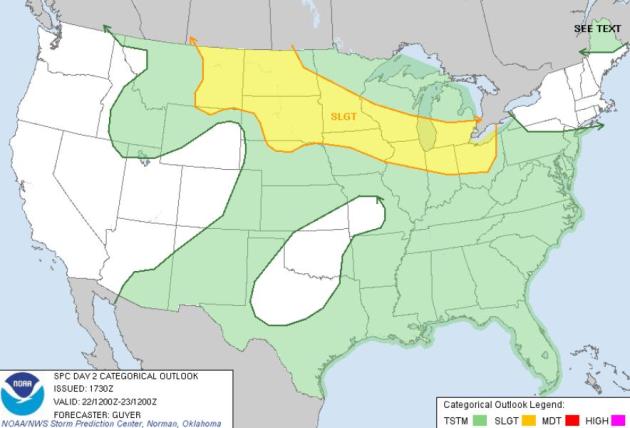 Today's Severe Risk
Today's Severe Risk. According to SPC the risk of severe storms will be greatest from the Dakotas to the Twin Cities, Madison, Chicago, Detroit and Columbus, Ohio, hail and damaging winds possible along the boundary separating oven-like conditions south from 50-degree dew points north.
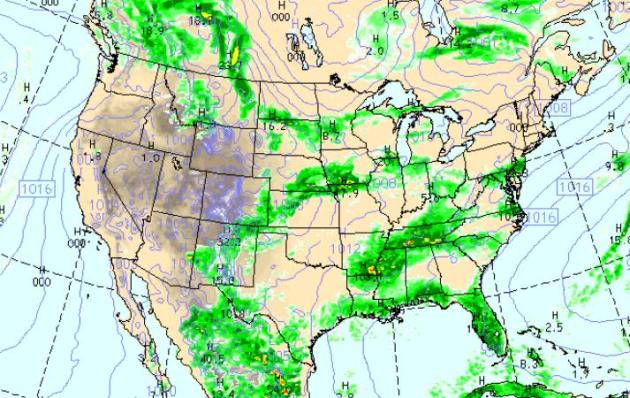 Friday Puddle Potential.
Friday Puddle Potential. Here's the WRF/NAM
model forecast, valid at 4 pm today. Storms may be severe from near Pierre, South Dakota to Alexandria and St. Cloud, Minnesota. More strong/severe storms may sprout from Des Moines and Omaha to the Front Range of Colorado. Storms capable of downpours will flare up over the Mid South, more sea-breeze storms for Florida, while Texas stays dry - and the western third of the USA is warm and dry.
Hot Weather Factoids:
- 5:45 p.m 7/20: The high temperature Wednesday in Rockford, IL hit 100 degrees. This is the first back to back 100 degree days in 23 years, per NWSChicago.
- The Champaign/Urbana area went 16 years without reaching the century mark, until a high of 100 degrees was measured on Tuesday July 19th.
- Hottest day in Rochester, NY since 7/6/1993 (98).
- Detroit hits 100 degrees for the first time since July 14, 1995.
- Developing: 29,000 without power in the heat in Michigan as temperatures top 100 degrees.
- Syracuse, NY (179" of snow last season) just hit 100 deg. for 1st time since '02. Nearing all-time record from 1936!
- @dallas_news "Yes, we officially hit 100 degrees this afternoon. That's 20 straight days, tying us for 5th longest streak". (Thursday)
- Elmira, NY breaks their ALL TIME record high by hitting 104. (Thursday)
- Fort Smith tied the record for consecutive days with 100 degree temps (17) by reaching 106 F Thursday; record falls Friday.
- It's been so hot in WitchitaFalls Texas. Today is the 30th consecutive day of triple digit heat!
- Including Thursday, Amarillo, Texas has had 27 100°+ days so far this year, breaking the record of 26 set in 1953.
July 20 Record Highs
Dalhart, TX 105
Borger, TX 104 (tie)
Amarillo, TX 103 (tie)
Raleigh, NC 100 (tie)
Wilmington, NC 99 (tie)
Madison, WI 97 (tie)
Marquette, MI 94
Bluefield, WV 89 (tie)
* Thanks to July Gaddy at EarthNetworks (formerly WeatherBug), for passing these records along.
July 20 Record High Minimums
Minneapolis 80
Peoria, IL 79
Moline, IL 78 (tie)
Rockford, IL 77
Dubuque, IA 76 (tie)
Washington, DC (Dulles) 75 (tie)
- A heat wave baking the central and southern United States was blamed on Wednesday for at least 22 deaths this week as forecasters warned that the abnormally hot weather could last into August as it moves east.
- With the number of days of extreme heat and humidity of the current heat wave, it may be more significant and impact a larger area than the deadly 1995 heat wave.
- The National Weather Service said 141 million people in 33 states were under a heat advisory or warning because of the soaring temperatures.
- The high heat and humidity have been stressing U.S. crops, particularly corn, which is now in a key growth stage when heat and moisture can cut final yields.
- Grain traders in Chicago and Kansas City also said the drought and heat in the Plains was beginning to cause concern about the fate of next year's output of hard red winter wheat crop, the primary bread wheat of the United States, which is grown in a parched swath from Texas to South Dakota.
- Farmers plant that crop each autumn and harvest the following summer. But if rains did not come soon, farmers may not plant wheat because of the powdery dry soil.
Heatwave Kills At Least 22 People. Here's an update from Reuters and the
Huffington Post: "
CHICAGO (Reuters) - A searing heat wave in the central and southern United States has killed at least 22 people this week, and forecasters Wednesday said the heat was moving east and could last for weeks. The National Weather Service said 141 million people in more than two dozen states were under a heat advisory or warning because of the soaring temperatures. The country's midsection has been scorched off and on since late May. In Wichita, Kansas, forecasters warned temperatures would hit at least 100 degrees Fahrenheit every day through Tuesday."
Thursday's Record Highs:
- Fort Smith, AR: 106 Old record: 104 in 2006
- Newark, NJ: 103 Old record: 102 in 1991
- Toledo, OH: 102 Old record: 99 in 1930
- North Little Rock, AR: 102 Old record: 101 in 2006, 2008
- Reading, PA: 102 (tie) Old record: 102 in 1926
- Raleigh-Durham, NC: 102 (tie) Old record: 102 in 1952
- Joplin, MO: 102 (tie) Old record: 102 in 1974
- Syracuse, NY: 101 Old record: 95 in 1930, 1933
- Harrisburg, PA: 101 (tie) Old record: 101 in 1991
- Detroit, MI: 100 Old record: 97 in 1926
- Wilmington, NC: 100 (tie) Old record: 100 in 1952
- Rochester, NY: 98 Old record: 97 in 1994
- Burlington, VT: 97 Old record: 94 in 1994
- Cleveland, OH: 97 (tie) Old record: 97 in 1952
- Erie, PA: 96 Old record: 94 in 1926
- Binghamton, NY: 95 Old record: 91 in 1955
- Mount Pocono, PA: 94 Old record: 92 in 1991
- Bluefield, WV: 91 (tie) Old record: 91 in 1983
- The worst is expected on Friday for the East Coast and the Mid-Atlantic, where heat index values could exceed 115°F.
- The following list includes cities that are forecast to come within 5° of their all-time records for July 22:
- Record High Maximum Temperature
- Boston, Mass.—100°F (forecast) 104°F (record, 1911)
- Newark, N.J.—102°F (forecast) 105°F (record, 1966)
- Washington D.C.—103°F (forecast) 106°F (record, 1930)
- Dulles Airport, Va.—103°F (forecast) 104°F (record, 1988)
- Central Park, N.Y.—102°F (forecast) 106°F (record, 1936)
- Providence, R.I.—100°F (forecast) 104°F (record, 1975)
Temperature And Moisture Extremes During This Week's Heat Wave. Here's a timely
post from the Twin Cities office of the National Weather Service: "
The heat wave which has gripped the upper midwest since Sunday has broken records for temperature and dew point, and possibly even heat indices across the region. Click here for a quick explanation of what dew point and humidity really mean."
In the Twin Cities:
- A record high minimum temperature was set on July 18th, when a low temperature of 80 degrees was recorded at Minneapolis - St. Paul International Airport. The previous record was 78 degrees which was set in 1986.
- A record high minimum temperature was also set on July 20th, when a low temperature of 80 degrees was recorded. The previous record was 76 degrees which was set in 1901, 1935 and 1940.
- The record high minimum temperature was tied on July 17th, with a low temperature of 79 degrees. The record was previously set in 1936 and 1942.
- A heat index value of 119 degrees was calculated from a temperature of 95 and dew point of 82 at the airport at 4PM on July 19th.
- A new hourly dew point record was set on July 19th:
...UNOFFICIAL DEW POINT RECORD SET IN THE TWIN CITIES ON JULY 19TH...
THE DEW POINT TEMPERATURE AT THE MINNEAPOLIS ST PAUL INTERNATIONAL
AIRPORT WAS 82 DEGREES ON THE 3 PM AND 4 PM OBSERVATION. THIS WAS THE
HIGHEST DEW POINT TEMPERATURE REPORTED ON AN HOURLY OBSERVATION AT
THE MINNEAPOLIS ST PAUL INTERNATIONAL AIRPORT SINCE HOURLY DEW POINT
RECORDS BEGAN IN 1945.
THE PREVIOUS HOURLY DEW POINT RECORD WAS 81 DEGREES...WHICH WAS SET
ON JULY 30TH 1999. A DEW POINT OF 81 DEGREES WAS ALSO REPORTED AT
THE AIRPORT ON SUNDAY...MONDAY...AND EARLIER TODAY /JULY 17-19/.
THE MINNESOTA STATE CLIMATOLOGY OFFICE IS THE OFFICIAL SOURCE OF
DEW POINT RECORDS ACROSS THE STATE. THIS NEW RECORD WILL BE
CONSIDERED UNOFFICIAL UNTIL IT IS CONFIRMED BY THE STAFF AT THE
STATE CLIMATE OFFICE.
Unreliable Dew Points? Just how accurate were the 80-degree-plus dew point readings over the Upper Midwest earlier this week? Is there an endemic problem with the equipment? Here's a
timely post from the Iowa State University Department of Agronomy: "
Our recent stretch of extremely hot and muggy weather has gotten Iowa a bit of publicity as some of our automated stations have calculated heat indexes that exceeded 130 degrees! Typically, this is blamed on the abundant transpiring corn crop in the state, but that is not the entire story. The primary source of automated weather data in the state are located at airports, but there are two classes of instruments. The federally administered ASOS sites have higher quality and sometimes different sensors than their state run AWOS counterparts. Unfortunately, their data is typically thrown together in the same pot and reported as such. While the ASOS sites did indicate gaudy heat indexes exceeding 110 at times, they were not as high as the AWOS sites which got all the headlines."
Farmers Battle Record Floods And Drought - On The Same Farm. What's that old saying? "Only in America can you be ankle-deep in mud with dust blowing in your face." Tell that to farmers in Mississippi - you won't get much disagreement.
Fox Business News has the story:
"Mother nature is every farmer’s best-friend -- and worst enemy. Deadly tornadoes, record flooding, and one of the worst droughts in recent history are making this year an especially challenging one for crop growers. In Mississippi, some farmers are facing flooded fields side-by-side with fields that haven’t seen significant rain in months. Billy Whitten can’t remember ever having to deal so much water and so little water at the same time, much less having the two extremes right next to each other. “This is very unusual this year to have the drought and the flood at the same time,” Whitten says. “Normally, when we have a flood, we have some rain to go along with it. This year we’ve had the flood and no rain at all, so we’re just getting it from both ends. We’re either flooded or drought destroyed it.” Flooding impacted more than a half-million acres of farmland in Mississippi. At the same time, 25-million acres, or 84% of the state’s land, is under some form of drought."
Heat Waves: A Climate Case Study. Here is an excerpt of an
important post from Dr. Jeff Masters at Weather Underground, author of the always-insightful Wunderblog, related to the extreme heat and drought underway across much of the eastern 2/3rds of America, a potential case study in longer, more intense heat events to come: "
Now if I was a public health official, and I was trying to understand how a warming planet might impact my life, then here is how I would think about it. First, the Gulf of Mexico and the Pacific are going to be warmer, and hence, there will be more humid air. This will mean, with regard to human health for the central U.S., heat waves will become more dangerous, without necessarily becoming hotter. It is also reasonable to expect heat waves will become more frequent and last longer, because those persistent, stuck high pressure systems are, in part, forced by the higher sea surface temperatures. If I am a public health official here is my algorithm – heat waves are already important to my life, and they are likely to get more dangerous, more frequent, and of longer duration. But by how much? Do I need to know by how much before I decide on a plan for action? If I think about the air being more humid, then I might expect to see trends in the heat index. I might expect to see trends in dew points, and trends in the nighttime minimum temperatures getting higher. (That’s where a greenhouse effect really matters.) I worry about persistent heat, warm nights, and the inability of people and buildings to cool themselves. I worry about their being dangerous heat in places where people and emergency rooms are not used to dangerous heat – not acclimated to heat – not looking for heat-related illness.

. This is a very encouraging development, details from
al.com: "
WASHINGTON -- New manufactured homes would come with weather alert radios under legislation approved today by a congressional committee. The proposal, from U.S. Rep. Spencer Bachus, R-Vestavia Hills, had bipartisan support and now goes to the House floor, where it has been well-received in years past but never advanced in the Senate. The April 27 tornado outbreak in Alabama where 244 people died may give the proposal new momentum. The House Financial Services Committee, where Bachus is chairman, approved it unanimously this morning after he reminded them that 100 people in his district died that day, although the deaths came in all types of homes, including site-built."
Weather Station Gets An Upgrade. More on the upgrade now underway to implement dual-polarization Doppler radar for the National Weather Service in this article from
enctoday.com: "
NEWPORT – With the peak of the hurricane season approaching, the National Weather Service forecast office in Newport is equipped with new weather radar technology that will better estimate heavy rainfall amounts and improve the accuracy of flood and flash flood warnings. The Doppler radar at the NWS office has been upgraded to incorporate dual-polarization, or dual-pol, technology. The Newport office is the second NWS office in the nation to receive the upgrade, with the remaining 120-plus NWS radars to receive the dual-pol technology over the next two years."
Flood Future. The Sacramento River Valley is extremely vulnerable to extreme flooding. Here's an excerpt of a story from
newsreview.com: "
California’s Next Nightmare prompts insurance, zoning changes in vulnerable Sacramento communities. There is some good news to go with the latest bad news about flooding in the Sacramento region. Just this month, The New York Times Magazine provided a graphic illustration of large parts of the city, including Midtown and downtown, under up to 20 feet of water in the event of a massive flood. The Times article, “California’s Next Nightmare,” cited a U.S. Geological Survey forecast that says such a flood in the Sacramento area is not only plausible, but also likely—and long past due. Several such floods have hit the area in the past, including one in the 1860s that had the governor rowing to his inauguration. A UC Davis geologist quoted in the story predicted a 64 percent chance of catastrophic levee failure in the next 50 years.
With these past and future floods in mind, government officials and lawmakers have been at work on better protecting Sacramentans. In the latest go-round, several communities will be reassessed for flood vulnerability over the next six months. And, in a related move, legislation is in place to ease the costs of flood insurance for property owners."
Ice-Dam Triggers Flooding Near Juneau. The story from
KTUU: "
The National Weather Service in Juneau has issued a flood warning Thursday morning after the burst of a glacial ice dam on a lake above the Mendenhall Glacier."
This Just In: Storms between Pee Pee and Lick, just northwest of Charleston. Take cover now.
"Sandwriting" Billionaire Sheikh Carves Out His Name In Desert In Capital Letters Visible From Space. Now THIS is the definition of cash-flow. Some guys have more time (and money) than good sense, as reported by the U.K.
Sun newspaper:
"A DESERT sheikh has carved out a big name for himself — by having his moniker etched in capital letters visible from space. Workmen scoured "HAMAD" into the sand on the orders of Abu Dhabi's Sheikh Hamad Bin Hamdan Al Nahyan. The name is two miles across — with letters a kilometre high. It is so huge that the "H", the first "A" and part of the "M" have been made into waterways. The mega-rich sheikh, 63 — a member of the ruling family of Abu Dhabi — in the oil-rich United Arab Emirates — boasts a £14billion fortune that is second only to the Saudi king's."
Monday Thru Friday: So Much For Getting Away. An instructive post from
failblog.com.
24-Hour Break. Admit it, it felt pretty good out there with dew point temperatures in the 50s. Highs ranged from 80 at Alexandria to 85 at St. Cloud, 86 in the Twin Cities and Grand Marais. Today dew points will spike into the 70s today as a serious case of the muggies returns to Minnesota.
Paul's SC Times Outlook for St. Cloud and all of central Minnesota:
TODAY: More clouds than sun, sticky again, isolated T-shower. Dew point: 72. Winds: SE 7-12. High: 87
FRIDAY NIGHT: Muggy and warm - slight chance of a T-storm. Low: 72
SATURDAY: Intervals of sun, steamy humidity. Few severe storms possible Dew point: 75. Winds: S 10-20. High: 88
SATURDAY NIGHT: Uncomfortably warm and sticky with more T-storms, locally heavy rain. Dew point: 74. Low: 73
*SUNDAY: Getting sunnier, becoming cooler and less humid - nicer day of the weekend. Dew point: 56 by evening. Winds: NW 10-15. High: 81
* nicer day for outdoor plans.
MONDAY: Sunny peeks, stray PM shower? Low: 63. High: 83
TUESDAY: Bright sun, reasonable humidity - best day in sight. Low: 62. High: 80
WEDNESDAY: Another round of T-storms. Low: 64. High: 82
THURSDAY: Storms far south, sunshine north. Low: 73. High: 88
Hot & Bothered
Welcome to the United (Sweaty) States of America: oven-like heat, jungle-like humidity; where almost every day is a "3-shower" day! Bring a towel.
According to NOAA an estimated 141 million Americans are under a heat advisory or warning; dozens have been killed. The heat will probably peak today in the northeast; the heat index may reach 110-115 from Boston and New York to D.C.
It's been an amazing July: 1,149 daily high temperature records, 3,826 records for warmest nighttime lows. That's just in July! What's remarkable is the intensity and duration of the heat, and the amazing dew point values, pushing 80 in many cities. I may have to fly out to Las Vegas to cool off.
We've picked up 11 days above 90 (average for the entire summer is 13 in the Twin Cities). At the rate we're going we'll easily see 20 days or more above 90 this summer.
We had our 1-day break; dew points return to the mid 70s today - near 80 tomorrow, making for a Saturday heat index near 105. A T-shower is possible today, more numerous storms Saturday - a few may turn severe. Sunday gets my vote for the better day; winds shift to the northwest, more sun, lower humidity (dew points drop into the 50s again) and a blob-free Doppler screen.
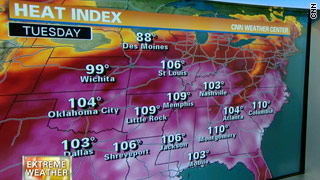
Climate Change Brings More Deadly Heatwaves. Here's an excerpt of a must-read story at
Huffington Post: "
Chances are that if you are living in the United States right now, you are experiencing sweltering heat. Blazing hot temperatures are blanketing much of the US. While July is always a warm month, the extent and duration of this year's heat is unusual and deadly. News reports indicate that people are dying in this protracted heat wave. Climate change most likely has a hand in this long, hot and dangerous summer. Here in Chicago, where the temperature may reach 100 degrees today, I am certainly focused on the heat. Like most of us caught up in the broiling temperatures blanketing our country, I am taking precautions. I am staying hydrated, working inside with the A/C going, avoiding any unnecessary trips outside, and making sure my family and my pets are safe. But not everyone is so well protected during a heat wave. The July 1995 Chicago heat wave led to more than 500 excess deaths in one week. Many high-level research studies published following the heat wave determined that most of the Chicagoans who succumbed to the heat were vulnerable elderly residents of this city who lived in high-crime neighborhoods, and were afraid to open their windows. Elderly people who often have underlying health problems are always more vulnerable to dehydration, heat stroke and death. During the Chicago heat wave of 1995, the addition of social isolation proved deadly for many people." (screen-grab courtesy of CNN).

It's Hotter Than It Used To Be; It's Not As Hot As It's Going To Be. The story from climate scientist, Peter H. Gleick, in
Huffington Post: "
Holy crap it's hot. People, animals, and crops are dying. But not only is it hot, it's hotter than it used to be. And it's our fault. Welcome to the future of climate change. Let's keep this simple: we know the Earth is warming up -- the data are unambiguous.* We know that humans are largely responsible -- the scientific community has been clear. And we know that the massive efforts to deny these two facts have confused policy makers, the public, and the media and have seriously delayed taking any sort of effective policy action to slow climate changes. What this delay means, however, is rarely discussed, but in the most straightforward terms: It's going to get even hotter. A lot hotter. Global warming is causing or worsening some of the extreme weather we're seeing. This influence of climate change on some extremes, including especially heat waves and heavy precipitation and some kinds of storm and flood events must no longer be waved away, swept under the rug, or otherwise ignored. It must become part of our daily discussion and debate. Until then, our politicians, in their air-conditioned chambers, under pressure from lobbyists and others who fear the policies that must inevitably be put in place to reduce our atmospheric pollution, will continue to look the other way." (photo courtesy of AP and Huffington Post).
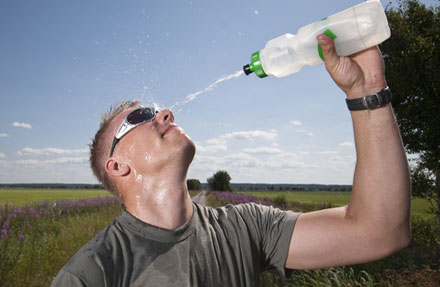
. Here's a story from the
Economist: "
A "HEAT dome" is descending on Washington. It's hovering over much of America, actually, sending temperatures into triple digits (or the upper 30s, if you prefer). This is just the latest in what has been a remarkable series of extraordinary weather events. America's south is experiencing a record drought. So, too, is the horn of Africa, where a famine may impact millions of people. In late June, an airport in Oman recorded the highest ever low temperature; on the evening of the 27th, the mercury failed to drop below 107 degrees Fahrenheit. Droughts, floods, deadly storms: the news is full of them. While it's not easy to attribute any individual event to climate change, it is clear that a hotter planet translates into a higher frequency of extreme weather events. When we emit carbon into the atmosphere, we impose a tiny negative cost on society as a whole in the form of more rapid global warm and a greater intensity of the accompanying social ills. Views of the magnitude of this cost differ. Many studies peg it at somewhere between $5 and $150 per tonne of carbon. Other studies indicate that it could be far higher—perhaps more than $1,000 per tonne. But the cost is positive, and a crucial first step to dealing with climate change, therefore, is to charge people for the carbon they emit. If you put a positive price on carbon, this price will be reflected in the cost of transactions, people will internalise the effect of their behaviour on the climate, and emissions will fall." (photo courtesy of worldweatherpost.com).
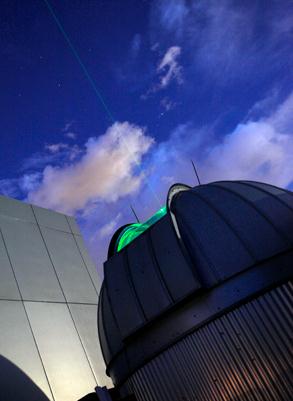
NOAA Study: Increase In Particles High In Earth's Atmosphere Has Offset Some Recent Climate Warming. Details from
NOAA: "
A recent increase in the abundance of particles high in the atmosphere has offset about a third of the current climate warming influence of carbon dioxide (CO2) change during the past decade, according to a new study led by NOAA and published today in the online edition of Science. In the stratosphere, miles above Earth’s surface, small, airborne particles reflect sunlight back into space, which leads to a cooling influence at the ground. These particles are also called “aerosols," and the new paper explores their recent climate effects -- the reasons behind their increase remain the subject of ongoing research. “Since the year 2000, stratospheric aerosols have caused a slower rate of climate warming than we would have seen without them,” says John Daniel, a physicist at the NOAA Earth System Research Laboratory (ESRL) in Boulder, Colo. and an author of the new study. The new study focused on the most recent decade, when the amount of aerosol in the stratosphere has been in something of a “background” state, lacking sharp upward spikes from very large volcanic eruptions. The authors analyzed measurements from several independent sources – satellites and several types of ground instruments – and found a definitive increase in stratospheric aerosol since 2000."
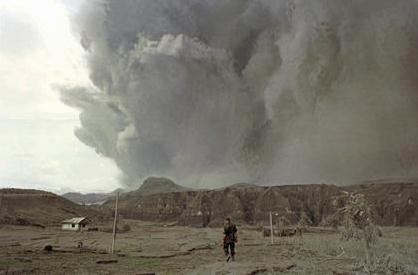
What Happened To Global Warming? A follow-up on the NOAA story above, from
USA Today: "
What happened to global warming? This week's heat wave notwithstanding, scientists have been puzzled as to why global warming has occurred at a slower pace since 1998, following decades of increasing temperatures. A new study out today in the journal Science reports the cause could be an increase in the amount of aerosols – tiny, airborne solid and liquid particles from both natural and man-made sources – high up in the stratosphere. In the study, scientists from the National Oceanic and Atmospheric Administration (NOAA) and other agencies found that an increase in stratospheric aerosols decreased the global warming that would have otherwise occurred by 25 percent since 1998. "There was less warming than you would have had without the aerosols," says study co-author John Daniel of NOAA's Earth System Research Laboratory in Boulder, Colo."
Uproar As BBC Muzzles Climate Change Skeptics. The U.K.
Express newspaper has the story: "
THE BBC was criticised by climate change sceptics yesterday after it emerged that their views will get less coverage because they differ from mainline scientific opinion. In a report by its governing body, the BBC Trust, the corporation was urged to focus less on opponents of the “majority consensus” in its programmes. It said coverage should not be tailored to represent a “false balance” of opinion if one side came from a minority group. The report was partly based on an independent review of coverage by Steve Jones, Professor of Genetics at University College, London. Although he found no evidence of bias in BBC output, he suggested where there is a “scientific consensus” it should not hunt out opponents purely to balance the story. He highlighted climate change as an example along with the controversy over the Measles, Mumps and Rubella vaccine potentially leading to autism. On climate change, Professor Jones said there had been a “drizzle of criticism of BBC coverage” arising from “a handful of journalists who have taken it upon themselves to keep disbelief alive”.
Climate Change, Past And Present: The Difference Is Humans. "
Climatide", a division of WGBH-TV in Boston, has the story: "We’ve all heard it, if not thought it ourselves: Climate is always changing. It’s a natural process. So what’s the big deal about climate change now? I heard this question posed yesterday at a public presentation by
Cape Cod National Seashore scientists about climate monitoring in the park. Having just spent the better part of two days with those same scientists learning about how the area is changing and the challenges natural resource managers there face, the answer seemed pretty clear: there weren’t seven billion people on the planet for those previous climate shifts. Our presence is making climate change worse for all involved. Here’s why:
- We’re speeding it up: The vast majority of climate scientists are convinced that greenhouse gas emissions from human activities are largely, if not wholly, responsible for current climate change. More importantly, the rate at which we’re putting carbon dioxide into the atmosphere is unprecedented. Consequently, the pace of climate change is also unprecedented. Adapting to major climate shifts is always a challenge, to put it lightly. Past global warming events have caused mass extinctions. With less time to make major evolutionary changes, things could get even uglier this time around.
UN Official Warns Climate Change Could Lead To Conflicts Over Resources. A story from
MSNBC.com: "
Climate change could result in "sudden and abrupt" shocks to countries around the world and have "far-reaching implications for global stability and security," a senior United Nations' official has warned. Achim Steiner, executive director of the U.N. Environment Program, told the U.N. Security Council Wednesday that natural resources would be "at increasing risk from climate change and its impacts." "There is a great deal of knowledge and analysis accumulated over many decades on the conditions and the triggers that can trip tensions and turmoil into conflict and war," he said. "There can be little doubt today that climate change has potentially far-reaching implications for global stability and security in economic, social and environmental terms which will increasingly transcend the capacity of individual nation states to manage," Steiner added."
Climate Change Skeptics Challenged. Details from the
coloradoan.com:
"Though climate change skeptics Fred Singer and CSU emeritus professor William Gray dismiss their views as "bunk" and "hokum," many atmospheric scientists at CSU agree that climate change is caused by humans, at least in part. CSU atmospheric science professor Scott Denning said there is nearly unanimous agreement among scientists in his department that human-emitted carbon dioxide will warm the planet. Singer, an emeritus professor at the University of Virginia who is known for his doubts about a connection between secondhand smoke and lung cancer, and Gray, who is famous for his research on hurricanes but has lately gained attention for his climate change contrarianism, spent nearly two hours at CSU on Monday evening attempting to convince an audience that climate change is harmless and helpful to humans. Worrying about climate change, Singer said, is a "psychosis." Gray downplayed peer review as necessary for scientific research and claimed that intellectuals and the "mainstream media" have been "brainwashed" into believing that climate change is human-caused and harmful.But John Calderazzo, a CSU English professor who is the co-director of the Changing Climates lecture series at CSU, said understanding climate change is difficult for many people, but they need to approach the issue with the willingness to pay close attention to the details with an open mind." (image courtesy of
american.com).
Climate Skeptics Get Too Much Air-Time, BBC Told. Here's an article from the U.K.
Independent newspaper: "
Climate sceptics who do not believe that man-made emissions of carbon dioxide are contributing to global warming have had too much air-time on the BBC as a result of its public broadcasting remit to be impartial, an inquiry has found. Inaccurate statements from those who challenge the scientific consensus on a range of subjects had frequently gone unquestioned in the BBC's attempts to be even-handed. Professor Steve Jones, who reviewed the broadcaster's science coverage at the request of the BBC Trust, said: "When faced with strongly opposed views in a scientific discussion, a journalist may not be certain of the facts presented on each side and may apply balance while describing it as impartiality – but if one proponent is presenting dubious evidence that claim is not justified. "For at least three years, the climate change deniers have been marginal to the scientific debate, but somehow they continued to find a place on the airwaves." (photo above courtesy of Skeptic Magazine).
Potential Shale Gas Extraction Air Pollution Impacts. Could "fracking" be compounding local air pollution problems, even injecting more water into the atmosphere, driving up dew points in the process? I don't pretend to have the answer, but there may be some unpleasant side effects to shale gas extraction, as reported by the industry blog, "
FracTracker": "
The Center for Healthy Environments and Communities has received numerous requests for information on how Marcellus shale gas extraction operations might contribute to air quality problems throughout the PA-NY-WV region, how air quality problems might develop in other shale plays around the country, and the potential human exposure to specific air contaminants generated in these processes. We are addressing this question in a very thorough academic fashion now by looking at the industrial processes involved from site clearance, to well drilling and hydrofracturing, to gas processing and methane and byproduct transport; we are developing conceptual site models of human exposure to contaminants generated by this very complicated industry with many sub-operations. A conceptual site model is a written and/or pictorial representation of an environmental system and the biological, physical and chemical processes that determine the transport and fate of contaminants from a source, through environmental media (air, groundwater, surface water, sediment, soils, and food) to environmental receptors (humans, aquatic and terrestrial organisms can all be environmental receptors) and their most likely exposure modes (ASTM, 2008). Again, because there are many sources and types of contaminants to understand and uncover within each gas extraction process, it will take until mid-fall to complete this study. In the meantime, here is basic information on potential air quality impacts from shale gas extraction activities." (map above courtesy of
chanceofrain.com).
Is A Murdoch Henchman Responsible For "Climate-Gate"? Here's an interview with Joe Romm, Senior Fellow at the Center for American Progress, on
The Current: "
The so-called "Climate-Gate" controversy -- in which e-mails about Global Warming were stolen from researchers at Britain's University of East Anglia in November, 2009 -- now turns out to bear the stamp of Neil Wallis, one of the key figures in Murdoch's hacking of the phones, voicemails, and other electronic communications of thousands of people. Keith unearths the truth with Joe Romm, editor of ClimateProgress.org. Keith also connects the dots in his latest blog."
When "Murdoch-Gate" Met "Climate-Gate". A follow-up article from
The Current: "
The Murdoch Phone-Hacking Scandal may have just metastasized. The so-called "Climate-Gate" controversy -- in which e-mails about global warming were stolen from researchers at Britain's University of East Anglia in November, 2009 -- now turns out to bear the stamp of Neil Wallis, one of the key figures in Murdoch's hacking of the phones, voicemails, and other electronic communications of thousands of people. Wallis is unique in this scandal. He had been the Executive Editor of Murdoch's News Of The World when hacking was at its peak. Yet in 2009 he wound up being hired by the police as a public relations consultant while the police investigated the hacking scandal. And he wound up spying for Murdoch's people on what Scotland Yard was investigating. Wallis was, as the New York Times put it, "reporting back to News International while he was working for the police on the hacking case." Moreover, while Wallis was keeping Murdoch's organization apprised of what and whom the police were investigating, the police were trying to convince other news organizations not to cover the story -- a suppression of evidence that benefited both the police and Rupert Murdoch. As the British newspaper The Guardian reported last Friday: "Scotland Yard's most senior officers tried to convince the Guardian during two private meetings that its coverage of phone hacking was exaggerated and incorrect without revealing they had hired Neil Wallis…"
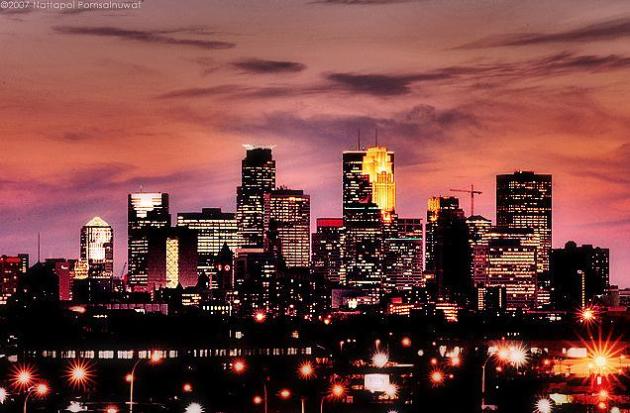





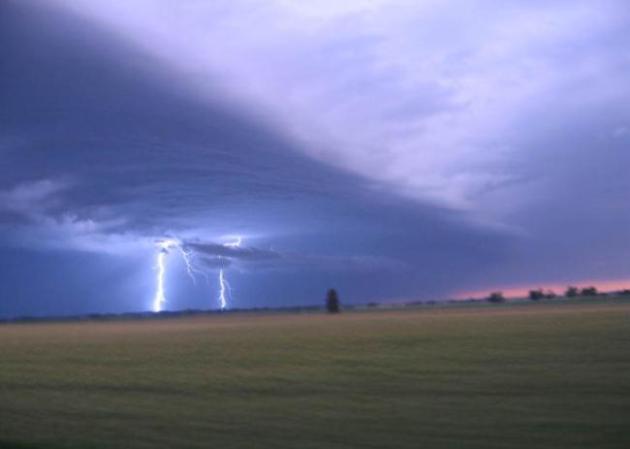









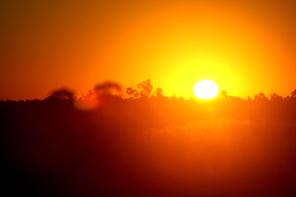
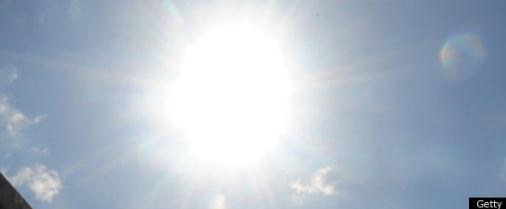

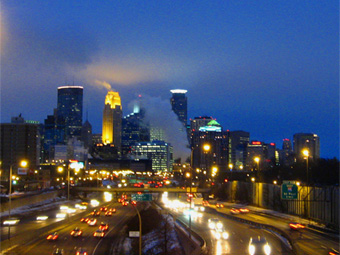
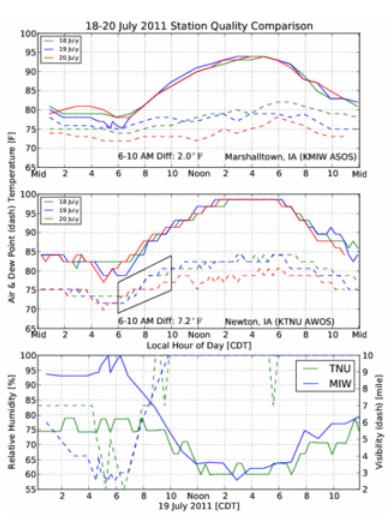
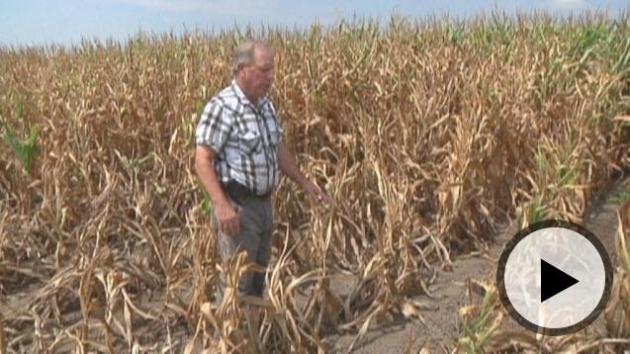
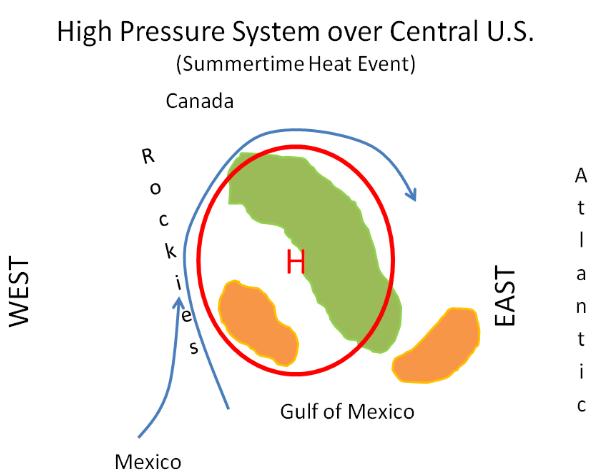


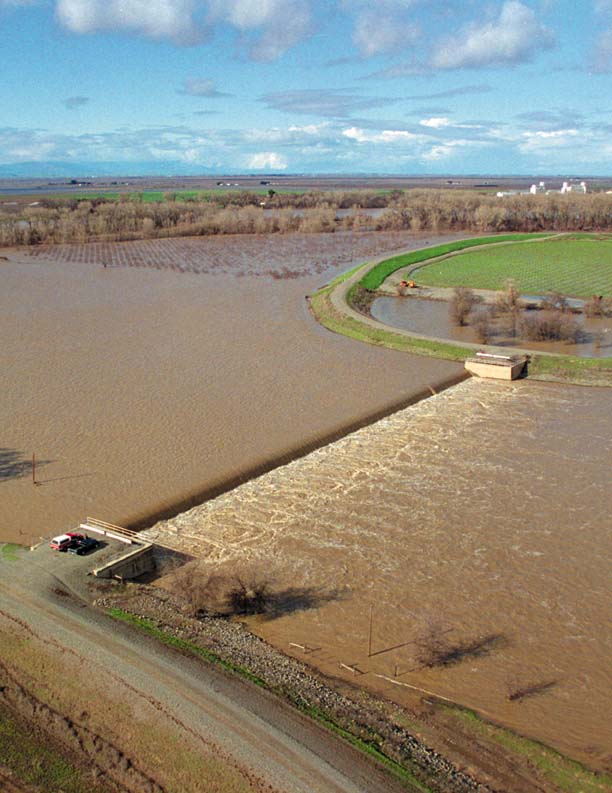
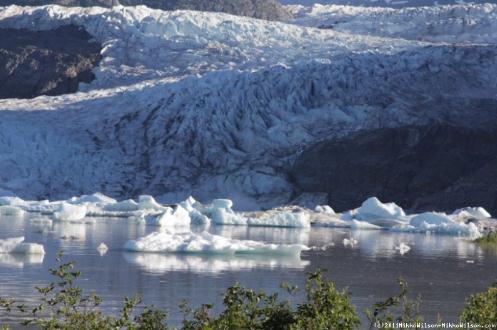
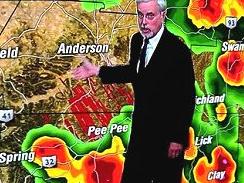
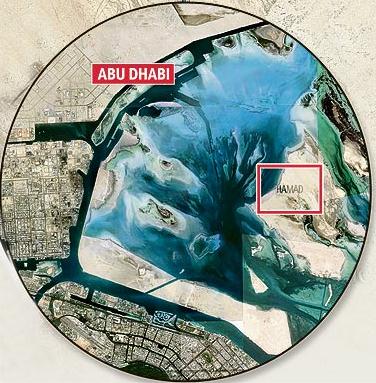
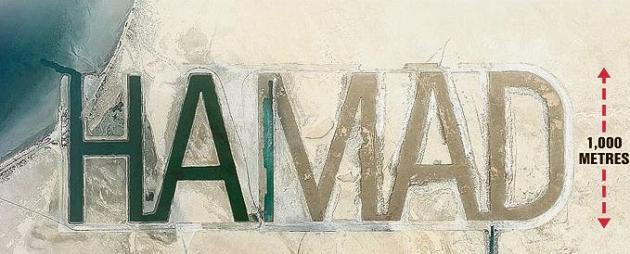
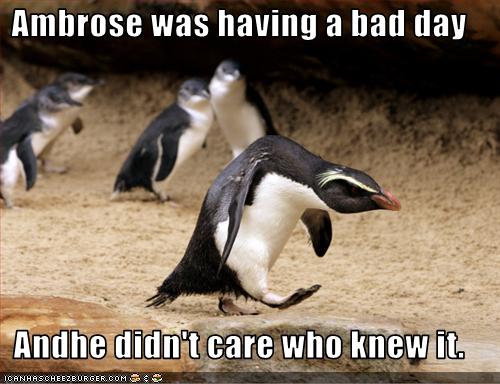
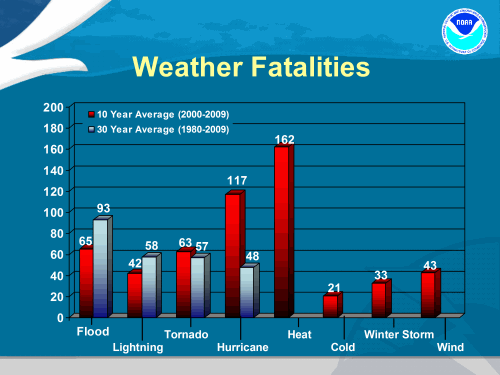







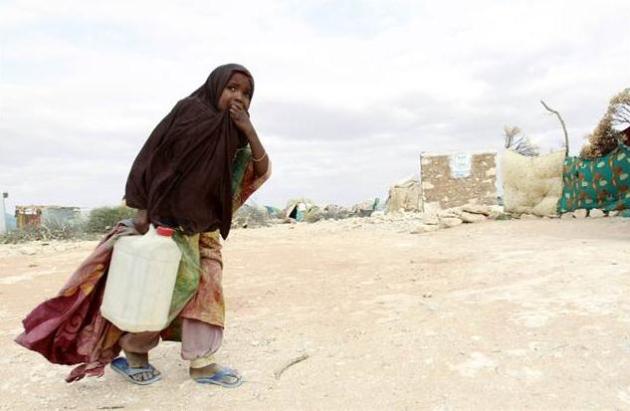
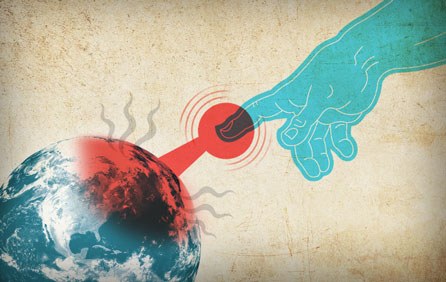
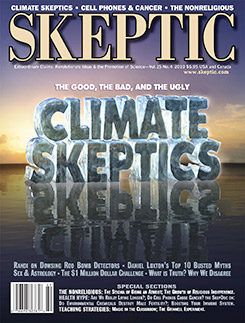

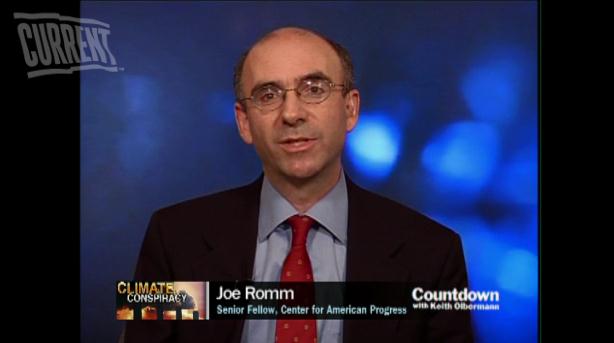


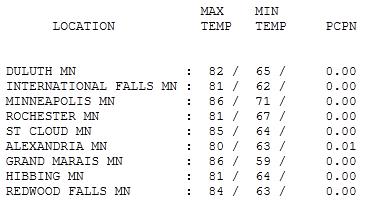
No comments:
Post a Comment